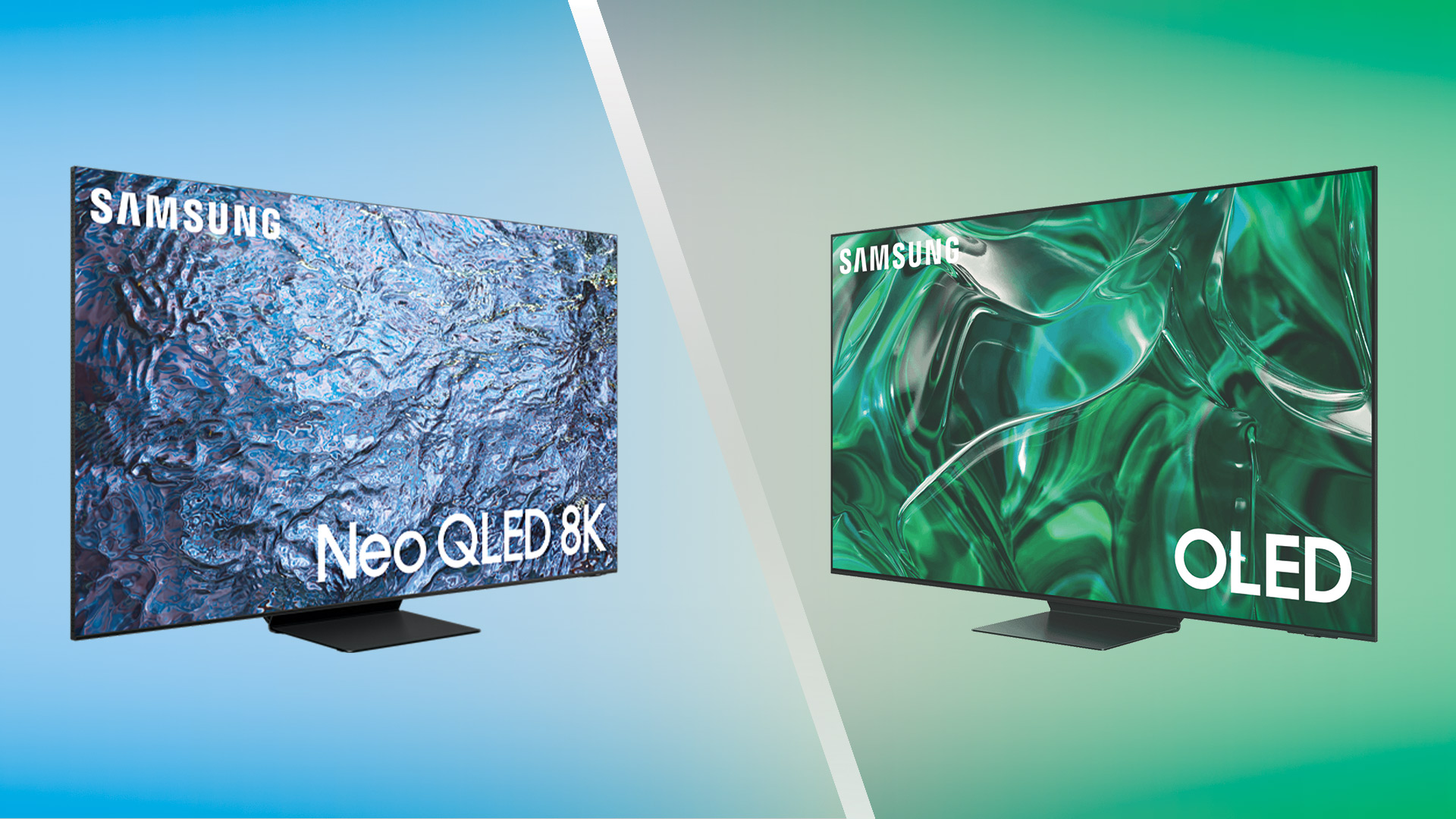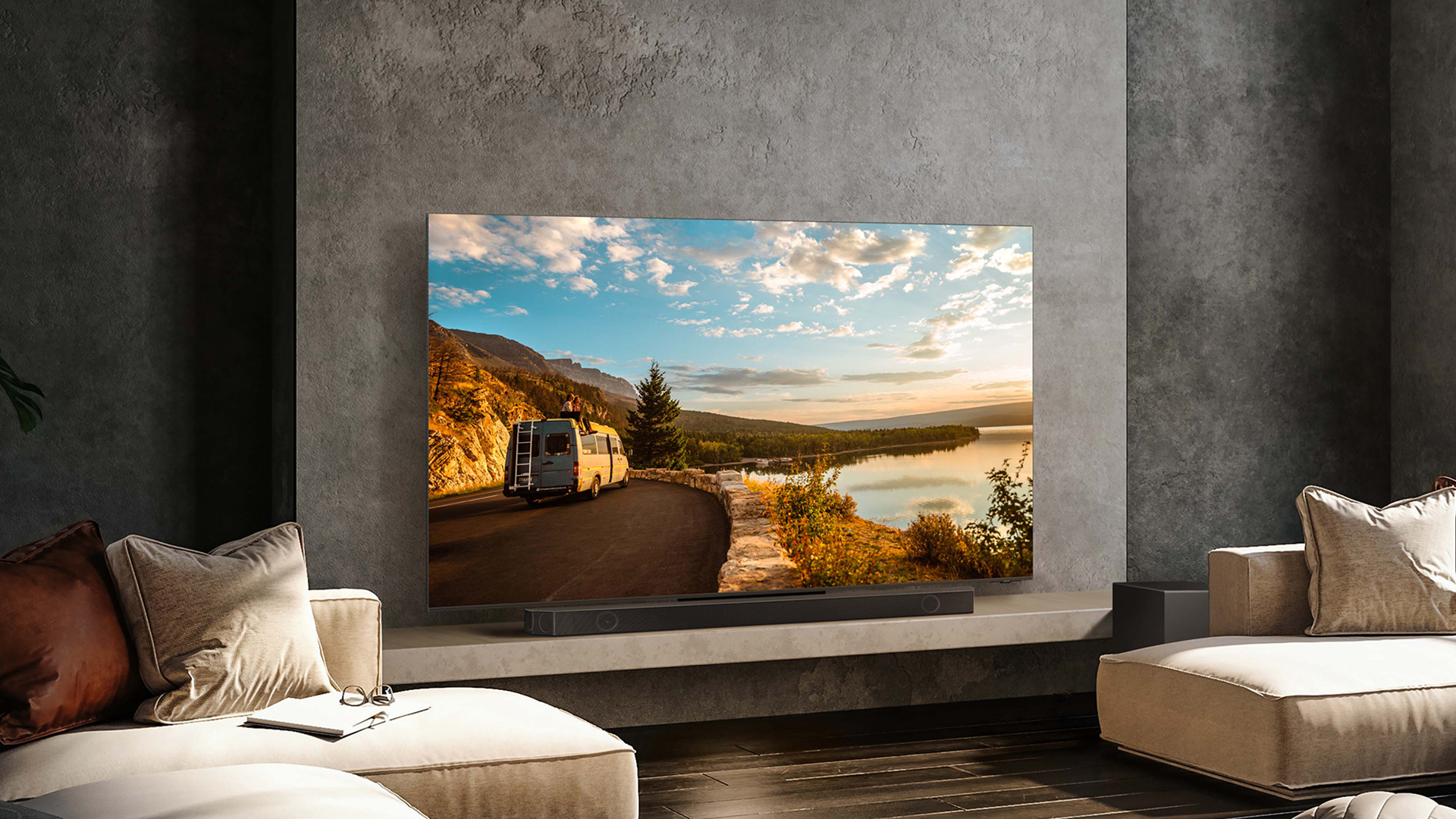Samsung QN900C Neo QLED vs Samsung S95C QD-OLED: Which TV should you buy?

Our Samsung QN900C Neo QLED vs Samsung S95C QD-OLED comparison is here to help you decide whether Mini LED or OLED TV tech is right for you. With any luck, you'll come away better informed about some of the best TVs of 2023.
For years, South Korean electronics giant Samsung resisted OLED TV technology by focusing all its efforts into maximizing the potential of LED-blacklit LCD televisions, doubling down on advancements like quantum dots and Mini LEDs.
So now that Samsung's Neo QLED TV range has arguably reached the pinnacle of what its LCD TVs can do, the manufacturer has opted to return to an updated version of OLED technology in QD-OLED, which introduces a quantum dot layer in place of a polarising filter for a brighter, more vibrant image.
Of course, both TV technologies have their own strengths and weaknesses, and it will ultimately be up to you to decide what kind of TV experience you want. Do you want an extremely bright TV, or is contrast more important to you?
To get to the bottom of this, we've pit Samsung's third-generation QN900C Neo QLED against its second-generation S95C QD-OLED to gauge each television's pros and cons.
So without further delay, here's our Samsung QN900C Neo QLED vs Samsung S95C QD-OLED comparison to help you decide which TV you should buy.
Samsung QN900C vs Samsung S95C: Price
We'll dive into the technology details shortly, but first let’s go over how much each TV costs in every available size option.
Get instant access to breaking news, the hottest reviews, great deals and helpful tips.
Samsung's QN900C Neo QLED 8K TV starts at $4,999 / £5,099 / AU$6,499 for the 65-inch model, before moving up to $6,299 / £6,799 / AU$8,499 for the 75-inch model and $7,999 / £9,599 / AU$10,999 for the 85-inch model.
For the Samsung S95C, pricing starts at £2,399 / $2,499 / AU$3,999 for the 55-inch model, followed by the 65-inch model at £3,599 / $3,299 / AU$4,999 and the 77-inch model at £5,099 / $4,499 / AU$7,999.
As expected for high-end TVs such as these, neither of them comes cheap. That said, Samsung's 4K QD-OLED range comes in significantly cheaper than its 8K Neo QLED range, likely due to the latter's resolution jump.
Samsung QN900C vs Samsung S95C: Design
Given that each option in our face-off come to us from Samsung, there are expectedly a few design traits shared by both televisions.
Firstly, we're happy to report that each TV is designed to make use of Samsung's excellent One Connect box — a detachable media receiver of sorts that houses all of its television's inputs, which are then passed through to the screen via a single cable connection.
The One Connect box can either be slotted onto the back of the TV's stand, or tucked away separately in a nearby cabinet. The latter option makes it especially easy for users to access their HDMI cables in a pinch — perfect for those who plan to wall-mount their TV.
Speaking of HDMI, both TVs offer four HDMI 2.1 ports (one of which offers support for eARC), making them ideal for next-gen gaming consoles, along with the usual assortment of USB, RF, Optical and Ethernet inputs.

Of course, there are a few key design differences between Samsung's QN900C Neo QLED and S95C QD-OLED televisions, and some of these may be noticeable enough to swing you one way or the other.
One thing we noticed is that the QN900C's bezel-free design doesn't quite carry over to the S95C, even if it is marketed as bezel-less. The QN900C's bezel measures less than a millimeter at just 0.8mm, while the S95C's bezel is far more obvious.
Although the S95C's bezel width isn't publicly available like it is on the QN900C, by eyesight alone we estimate it to measure at least 5mm — maybe more. That's reasonably thin, but it's still a noticeable black window around your content, and a far cry from the borderless effect that Samsung's top-end Neo QLED provides.
That said, what the S95C lacks in bezel invisibility, it makes up for with its display's incredible thinness. With a depth of just 0.4 inches (10.16mm), the S95C's slim profile is certainly striking. It's thinner than the QN900C, which has a depth of 0.6 inches (15.4mm).
Another big difference between the two is their speaker offerings. The QN900C provides a slightly more robust 6.2.4-channel built-in setup, while the S95C delivers 4.2.2 channels of sound. It's also worth mentioning that the former has visible speaker grilles along the sides and top of its display, while the latter does not.
Samsung QN900C vs Samsung S95C: Performance
Right, let's get the obvious out of the way first — the QN900C is an 8K TV, while the S95C is a 4K TV. That means the QN900C is able to display twice as many vertical and horizontal pixels, which equates to four times as many pixels overall.
In summary, the 4K TV's resolution of 3840 x 2160 brings the total number of pixels to around 8.3 million, while the 8K TV's resolution of 7680 x 4320 adds up to roughly 33 million pixels.
Given the sheer number of pixels it's working with, and the additional grunt required to upscale to 8K, the QN900C requires beefier processors than its rival, which it has in the Neural Quantum Processor 8K and the Neo Quantum HDR 8K Pro. In practice both TVs perform equally well from a processing standpoint, without any noticeable hitching or image scrambling to speak of.
Of course, the viewing experience on each television is quite different due to its respective technology. The QN900C employs Mini LED backlighting to achieve far more accurate contrast than a traditional LED-backed LCD television through over 1,000 dimming zones.
Although Mini LEDs are 1/40th the size of a regular LED, they still can't reach the level of lighting precision as the OLED technology of Samsung's S95C, where every individual pixel is self-lighting. Samsung may have significantly minimized light blooming on the QN900C, but it's completely non-existent on the S95C.

That also leads to Samsung's S95C QD-OLED achieving slightly better color saturation than its competitor, with HDR content covering 99.18% of the UHDA-P3 Color Gamut, as opposed to 93.04% coverage on the QN900C.
But while the S95C may have the edge in terms of color saturation, the QN900C has it thoroughly beat in terms of color accuracy — in our Delta-E test, where lower numbers are preferred, the QN900C measured just 2.8686, while the S95C a slightly less impressive 4.0946.
One area where the QN900C beats its OLED rival is peak brightness. Although the S95C is admittedly very bright for an OLED television, achieving 1374.3 nits in a 10% window, the QN900C smashes that number with a whopping peak luminance of 2,433.6 nits — that's greater than any other TV we've tested in recent memory.
It's also worth noting that due to OLED's prevalence for burn-in, Samsung's S95C sports some rather aggressive countermeasures which can't be turned off, such as a screen saver which seemingly appears after 30 seconds of inactivity, and some noticeable auto-dimming.
Samsung QN900C vs Samsung S95C: What should you buy
So which TV should you buy? We have to admit, judging which TV is the best is more than a little tricky in this instance, as the pendulum keeps swinging back and forth between the QN900C and the S95C.
Each television clearly has its own strengths and weaknesses, but it will ultimately be up to you to decide which features matter more to you.
Do you favor brightness over contrast? If so, the QN900C Neo QLED is for you. Of course, if color saturation is more important to you than color accuracy, you may want to go for the S95C QD-OLED.
Or maybe it simply comes down to resolution. If that's the case, the QN900C's 8K panel delivers four times as many pixels as the S95C, though that may not matter much unless you go for a really big screen size.
Personally, I would opt for the QN900C based on its incredible brightness and the peace of mind that comes from never having to worry about burn-in. That said, the S95C's black levels and contrast are exceptional, and the fact that it can achieve this while maintaining excellent brightness and vibrant colors is a boon for OLED enthusiasts.
Of course, you can make an even more informed decision by checking out our in-depth reviews of both the Samsung QN900C Neo QLED and the Samsung S95C QD-OLED.
More from Tom's Guide

Stephen Lambrechts is the Managing Editor of Tom's Guide AU and has written professionally across the categories of tech, film, television and gaming for the last 15 years. Before Tom's Guide, he spent several years as a Senior Journalist at TechRadar, had a brief stint as Editor in Chief at Official Xbox Magazine Australia, and has written for such publications as APC, TechLife Australia, T3, FilmInk, AskMen, Daily Telegraph and IGN. He's an expert when it comes to smartphones, TVs, gaming and streaming. In his spare time, he enjoys watching obscure horror movies on physical media, keeping an eye on the latest retro sneaker releases and listening to vinyl. Occasionally, he also indulges in other non-hipster stuff, like hiking.
